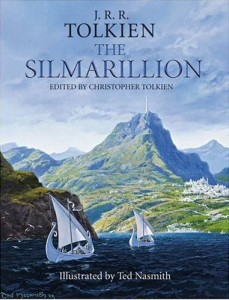 Our friend C.E. High recently sent us an interesting take on making The Silmarillion into a trilogy of movies. While the odds of that happening are almost nil, it’s still fun to think about how it could be done. Which stories would make the best cinematic exposé in terms of both content and characters? What would have to be cut to keep the storyline cohesive? Have a look at C.E.’s essay, then let us know what your Silmarillion trilogy would look like!
Our friend C.E. High recently sent us an interesting take on making The Silmarillion into a trilogy of movies. While the odds of that happening are almost nil, it’s still fun to think about how it could be done. Which stories would make the best cinematic exposé in terms of both content and characters? What would have to be cut to keep the storyline cohesive? Have a look at C.E.’s essay, then let us know what your Silmarillion trilogy would look like!
The Silmarillion as a Movie Trilogy – by C.E. High
It’s an idea that has been capturing the minds of fans since the days of Peter Jackson’s The Lord of the Rings movie trilogy and probably before that too; will Peter Jackson or anyone make The Silmarillion into a motion picture? After the success of The Lord of the Rings franchise, the natural question was “When will he make The Hobbit?” Ten years, eleven Oscars and a few green light hitches later, we have just been treated to the second Middle-earth film trilogy. Old fans are loving the opportunity to delve back into the world of Tolkien again, new fans are discovering it for the first time and at the end of it all, naturally (and hopefully), we still want more. Eyes have already been looking toward The Silmarillion – Tolkien’s posthumously released life’s work telling the story of the First and Second Ages of the world, the awakening of the Elves, Dwarves, and Humans, and the events that ultimately create the world that we know from The Hobbit and The Lord of the Rings.
The first question we must answer is a legal one. Who owns The Silmarillion? The rights to this book are currently owned by the Tolkien Estate – and judging by their disapproval of the films made to date, (Christopher Tolkien said “They took a great work of high fantasy and turned it into an action movie for young people.”) they don’t seem to be in a rush to sell them. J.R.R. Tolkien himself sold the film rights of The Hobbit and The Lord of the Rings back when he believed they were un-filmable and decided he would like some money to retire on. The Silmarillion, along with Unfinished Tales of Numenor and Middle-earth and other works by Tolkien which were released after his death, remain in the possession of the Tolkien Estate and because of this, the prospect of a Silmarillion movie happening in the near future is unlikely.
That being said, in a scenario where a Silmarillion film – or series of films – were to be made, would they even work as movies? Would they stand the test of the general movie-going audience? How would it translate to the big screen? Could it be translated to the big screen? This article will explore the possibilities and pitfalls of translating The Silmarillion into film by looking at a potential treatment of the films and a brief analysis of the text itself.
The Lord of the Rings was claimed for years to be an un-filmable book. It was too long and complicated and its scale and fantasy were massive, but at least it boasted an actual central plot. The Silmarillion unfortunately does not have a central narrative. Those who have read The Silmarillion will know that it is written as a history more so than a novel. It has no central character that drives the story throughout, and very few dialogues. Instead, it follows certain characters through various episodes in the history of, and before, the First Age. Characters such as Fëanor, Beren and Lúthien, Turin, and Earendil are set up as central characters but their roles only last within their own contained episodes, while the history continues. So how would this work in film? With this idea in mind, I split The Silmarillion into three movies, attempting to capture the key moments from the book in a way that can hopefully make sense. I have also given each film a theoretical title with the entire trilogy simply being called The Silmarillion.
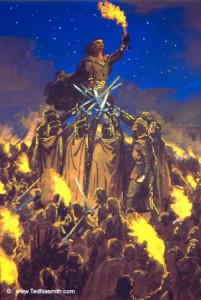
by Ted Nasmith
Film 1 – The War of the Jewels
The central plot of Film one would be based around Fëanor and the creation of the Silmarils. Unfortunately, so much detail would already need to be shortened, cut, or simplified. An extensive prologue would depict the creation of the world, the Valar, the awakening of the Elves and life in Valinor. Our antagonist is introduced as Melkor, who becomes Morgoth. He is an interesting character in this book, as he gets more characterization than Sauron gets in The Lord of the Rings. He is, of course, our central villain: a Valar who, through his lust for power, turns evil. Fëanor – our inventive, passionate, curious elf protagonist, creates the Silmarils, the jewels that capture the light of the Trees of Valinor – the only source of light in the time before the making of the sun and moon. The first major event would be Melkor and the giant spider Ungoliant sucking the light and life from the Trees, killing Fëanor’s father, and stealing the Silmarils – thus sparking the War of the Jewels. Fëanor names him Morgoth, and vows to follow him back to Middle-Earth to retrieve them.
Fëanor seizes the boats from the elves of Alqualondë, committing the act of Kinslaying and cursing his people, the Noldor, by leaving Valinor. Fëanor reaches Middle-Earth with his followers and burns the ships. Fëanor’s half-brother Fingolfin follows with his people, but must cross the Grinding Ice in the North.
Morgoth would raise his army from his fortress in Angband to meet Fëanor, and thus the Battle Under the Stars would be fought and Fëanor would ultimately have his fight to the death with Gothmog, the Lord of Balrogs. Gothmog will be a recurring character throughout the three movies. Fëanor’s death would set a dark and tragic tone to the end of this film leaving his sons chiefly, but also all the remaining Noldor caught in the curse of the Valar that Fëanor brought on them, and in perpetual war with Morgoth. The entire film would be dark both figuratively and literally, however it could end with the rising of the sun and moon.
Film 1 Summarized:
- The Creation of Arda and the Trees and chaining of Melkor
- The Awakening of Elves and their Journey to Aman.
- The Creation of the Silmarils
- The theft of the Silmarils and oath of Fëanor
- The Kin slaying and Doom of the Noldor
- The Battle Under the Stars and slaying of Fëanor
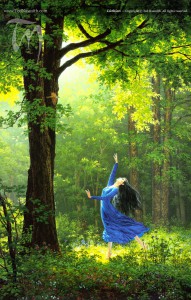
by Ted Nasmith
Film 2 – The Love of Lúthien
This film, unlike The Lord of the Rings and The Hobbit, wouldn’t pick up straight from where the previous film ended. An interesting feature of the narrative in this book is that the main characters are elves and thus the story spans centuries and not mere months. The Glorious Battle and the elves laying siege to Angband for 400 years leading to a prologue would allow the audience to catch up on the settlement of the Noldor, the kingdoms of Nargothrond, Gondolin, and Doriath. The Awakening of Men and Dwarves would also need to be established. The Battle of Sudden Flame and the duel between Fingolfin and Morgoth would act as an exciting opening similar to The Battle of the Last Alliance and the Balrog fight in The Lord of the Rings. This would also establish Angband for this movie as well as giving a backstory to the Ring of Barahir from Finrod Felagund.
The story of Beren and Lúthien would be the core plot of film two. We would be introduced to the man Beren retrieving his father’s ring from a band of orcs. He would wander his way into the forest of Doriath to discover the elf Lúthien. He asks for her hand from her father Thingol, the king of Doriath, who demands Beren return with a Silmaril in his hand: the jewels Morgoth had placed in his iron crown. We follow the adventures of Beren, Lúthien and the hound Huan to Angband, where they retrieve a Silmaril from a sleeping Morgoth and encounter the great wolf Carcharoth. Beren tries to fend him off with his newly stolen Silmaril, but the giant wolf, of course, logically bites his hand off, fleeing in pain in a violent rampage as the Silmaril burns in his stomach. Beren and Lúthien return to Thingol explaining that technically the Silmaril is in Beren’s hand, although not attached.
The climax would be the hunting of Carcharoth, in the woods of Doriath. Huan and Carcharoth will have a violent fight to the death, ultimately resulting in the death of Beren. Lúthien dies of heartbreak, and charms Mandos and Manwë (the Valar of death and king of the Valar respectively) to talk Eru Ilúvatar (god) into giving Beren a second life. This would be a tricky enough concept to pull off right at the end of this movie, but then again if in The Two Towers film Gandalf is shown being given new life, it could be done, and thus we would have a lovely happy ending to this second film.
Film 2 Summarized:
- The Siege of Angband
- The establishment of the three hidden kingdoms
- The battle of Sudden Flame and the death of Fingolfin
- The story of Beren and Lúthien and the quest for the Silmaril
- The death and resurrection of Beren and Lúthien
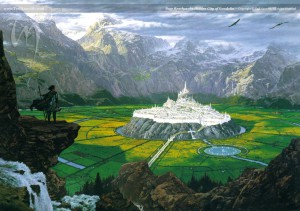
Film 3 – The Breaking of the World
If film two was the easiest to adapt, film three is the most difficult to put together as it would be the most disjointed and possibly would even need a fourth film. It contains so many important events, but with very little solid relationship to each other. In the adaptation process these links could be made artificially, but I’m not going to make them here. It is here that we would employ the Sin City/Pulp Fiction chronology-jumping storytelling style the most.
This film would open with The Battle of Unnumbered Tears, and the fight between Elves, Men(Edain), Dwarves, Orcs, Balrogs, Dragons, and pther Men(Easterlings), the capture of the man Hurin, and details about the secret kingdom of Gondolin (possibly jumping backwards in time to tell the story of Eol the dark elf). We could first have the episode of The Children of Hurin, the tragedy of the mighty warrior, Turin, his son who is cursed, deceived by Glaurung the Dragon into marrying his own sister and who eventually throws himself on his own blade after all is revealed, this also includes the Fall of Nargothrond (This could possibly be its own film, and only eluded to in this trilogy).
The Ruin of Doriath and the battle between elves and dwarves could be shown here, but it would require setup.
After the fall of Doriath, the story of the man Tuor being lead to Gondolin as a warning leads to the story of the Fall of Gondolin, and birth of Eärendil the Mariner. Peter Jackson made many references to Gondolin in his films. The significance of the depiction of the Fall of Gondolin is that it was the first thing Tolkien wrote about Middle-Earth while recovering from the trenches in World War I. It is so iconic in Tolkien’s work, plus it would be a nice link to see the swords Glamdring, Orcrist and even possibly Sting in action; another connection with the Jackson films.
The final act is tricky because the hero is someone who would be born halfway through the film, the half-elven Eärendil. Beleriand (the region of Middle-earth where all of these events takes place) is overrun with orcs, and Morgoth is tightening his inevitable victory after the battle of unnumbered tears. A final plea to the gods, the Valar, is needed. Eärendil, the mortal (and father of Elrond half-elven no less), leaves to sail west with the Silmaril that he has, to beg the Valar to intervene. He makes it across the sea to Valinor, where he convinces the Valar to come to Middle-Earth, leading to the War of Wrath – a battle of continental scale, which was so destructive that most of Beleriand is sunk into the sea, resulting in the coastline of the second and third ages of Middle-Earth that we now know and love. This would have to have “apocalyptic” imagery and awesome aerial battles between Dragons and the Valar, Elves and Orcs, Men and Balrogs, and Eärendil’s flying ship. Morgoth is defeated in this conflict and cast into the void outside the confines of Arda.
For aid in the war, some humans are gifted long life and the island of Numenor. The Silmarils are ultimately lost out of reach of the world and bring an end to the War of the Jewels and the First Age. Eärendil is rewarded with sailing across the stars forever more with the light of the Silmaril.
This is a much more difficult story to bring to the screen than the other two, and without making drastic changes and edits, I’m not sure it could be done justice.
Film 3 Summarized:
- The Battle of Unnumbered Tears and the taking of Hithlum by Easterlings
- The Fall of Doriath and escape of Elwing with the Silmaril(where the Fall of Nagothrond is eluded to but details are saved for a film about the Children of Hurin)
- The Fall of Gondolin and the escape of Earendil South
- Eärendil’s voyage west to Aman
- The War of Wrath and the Banishment of Morgoth
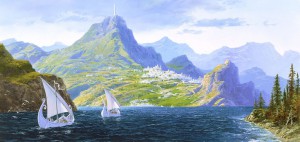
Challenge: Would the general movie going audience be put off with the much darker and tragic tone of The Silmarillion films with many characters that they grow to care for meeting tragic ends? I don’t think so as long as you have great character development, and with Tolkien that isn’t hard. The stories more often than not end with the protagonist dying, or the city you’ve grown to love being razed to the ground. The Second Age and The Fall of Numenor are a source of even more stories that could get their own movies: an age of dark times for Middle-earth as the wise and learned men, and many of the elves, move west to Numenor and Valinor leaving those that remain to struggle against the newly arisen dark lord Sauron who will create the rings of power.
When you really think about this being made into a trilogy or perhaps even a longer film sequence one does get excited. If you are like me than you might get a little apprehensive; one of the things about the two Jackson trilogies that struck me was that I thought a bit too much was left out of the LOTR films and a bit too much was added to the Hobbit films. Also speaking of Hobbits something that I find very difficult to reconcile, this would be a Tolkien film trilogy without any hobbits. No hobbits to bridge the audience between modernity and the wild world as it were.
The final verdict on these films? It would take a movie studio moving heaven and earth to make them. Perhaps the studio could look to Marvel Studios and what they have done with their universe for an example? Just a thought.
– C.E. High is a European history teacher and Tolkien Scholar living and working in Texas


